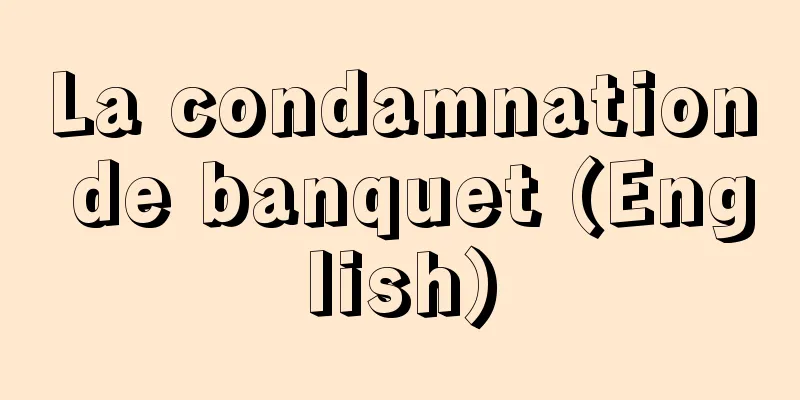Flowers - Kuge

|
Flowers offered to Buddha or the dead. They can also be written as kuge or "kuuge." Buddhism has had a deep connection with flowers since its inception, and their merits are explained in the scriptures, with flowers being considered the first offering to Buddha. The style of flower offerings on Buddhist altars was also followed in the Muromachi period's room decorations, with vases being placed and flowers inserted, which eventually gave rise to ikebana. Meanwhile, flower offerings have also taken root in various forms in folk events. Offering flowers at funerals on the graves of the deceased or ancestors is the same as offering flowers, but there are also other types of offerings, such as "hanakago" displayed outside the house, in which five-colored pieces of paper are placed in a basket and scattered at the front of the funeral procession, called "sange," a variation of the "hanakago," and "shikabana," in which paper petals are attached to bamboo skewers and placed at the bedside of the deceased or on the gravestone, and in Kyoto funerals, where shikimi is wrapped in white cloth, which are considered to be offerings of flowers like shikimi. It is a common custom to offer bonbana during the Bon and Higan periods, but there are also various other customs, such as flowers being offered all the time in seaside village cemeteries, or in snowy areas where there are no flowers during the spring equinox in northern countries, small snow caves are made on top of the graves, candles are lit, and cedar leaves are offered inside instead of flowers, or artificial flowers are used instead. The stone slabs that were used as stupas for common people in the Kamakura period have inscribed on them the floral tributes that were considered solemn at the time. Many of them are in the form of a triad, but in their compositional and abstract handling we can see connections with the later forms of ikebana. The three-branch structure of ikebana can also be traced back to the form of floral tributes. [Hojo Akinao] Source: Shogakukan Encyclopedia Nipponica About Encyclopedia Nipponica Information | Legend |
|
仏あるいは死者に供える花のこと。供華とも書き、「くうげ」ともいう。仏教は発生当初から花と深くかかわっていて、教典にもその功徳が説かれ、花は仏の供養の第一とされた。室町時代の座敷飾りにも仏壇飾りの供花の形式が踏襲され、花瓶が置かれ花が挿され、やがてそこからいけ花が生まれた。一方民間行事としても供花はさまざまな形で定着する。葬式の死者や祖先の墓に花を供えるのは供花そのものだが、家の外に飾る「ハナカゴ」のように、籠(かご)の中に五色の紙片を入れ、葬列の先頭でこれをまき散らす散華(さんげ)、そのハナカゴの変化した花輪、また「シカバナ」とよばれる竹串(たけぐし)に紙で花弁状のものをつくって張り付けたものを死者の枕元(まくらもと)や墓石に置くもの、京都の葬式のようにシキミに白布を巻いたものは、シカバナと同じ、花の供養と考えられる。盆や彼岸のとき盆花を供えるのは一般的風習だが、海辺の村の墓地では常時花が供えられるとか、春の北国の彼岸には花がなく、積雪地では墓の上に小さな雪洞(ぼんぼり)をつくり、ろうそくをともして中に杉葉を花のかわりに供えるとか、造花を代用させる場合など多様である。 鎌倉時代の庶民の塔婆である石の板碑には当時の荘厳(しょうごん)の花としての供花が刻まれている。多くは三尊の形式をとっているが、構成的、抽象的な扱い方のなかに後のいけ花の形式とのかかわり合いをみることができる。いけ花が3本の枝の構成をもつのも、供花の形式にその端緒が求められる。 [北條明直] 出典 小学館 日本大百科全書(ニッポニカ)日本大百科全書(ニッポニカ)について 情報 | 凡例 |
Recommend
God of the fields - Tanokami
A general term for gods who help rice grow and br...
Parrot beak - Parrot beak
...Svay Rieng province (area: 2,900 km2, populati...
Mandato de segurança (English spelling)
... The bitter experience of political instabilit...
Kaifu clan - Amabeuji
…In 877 (Gangyo 1), it was designated as a Myojin...
Scampa
...the capital of the eponymous county, with a po...
Diversification of management
The expansion of a company's business activiti...
Cardiac steroids
...Inotropes that act directly on the myocardium ...
Iki-Tsushima Quasi-National Park
A quasi-national park centered on the scenic coas...
Phonograph record
...A disk on which linear grooves are carved in a...
Invincible
After World War II, no country could possess a mo...
Paul Alexander Baran
1909‐64 Ukrainian-born American Marxist economist....
Cassia - Cassia (English spelling)
An evergreen tall tree of the Lauraceae family (A...
Freezing rain - Uhyoh
Raindrops that are supercooled near or below free...
City-state (English spelling)
A human association or organization in which a ci...
Guild - gild (English spelling)
In medieval Western Europe, a professional associ...






![Kisa [town] - Kisa](/upload/images/67cb50686875a.webp)


